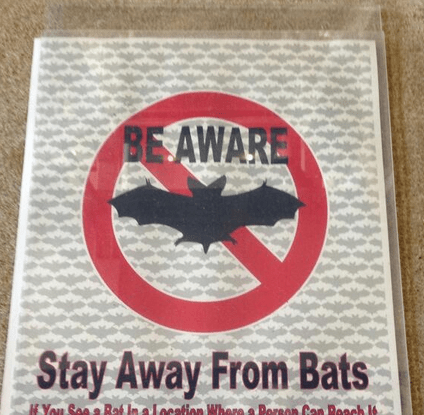ADPH: Do not handle bats
Published 10:30 pm Sunday, February 25, 2024

- Bats
Officials with the Alabama Department of Public Health are cautioning the public to not to handle bats. Bats, along with raccoons, are the primary reservoirs for rabies in Alabama. Rabies is a viral infection in mammals that is transmitted by bites, scratches or other contact with infected saliva. Rabies virus is present only in saliva and nervous tissue; it is not transmitted through contact with guano (bat feces), blood or urine from infected animals.
Rabies is a fatal disease if left untreated, but it is preventable if proper treatment is received soon following the bite or scratch. Anyone exposed to a bat should consult with a medical provider immediately.
Estimates vary, but generally it is estimated that only a small percentage of the bat population is positive for rabies. Oftentimes infected bats will not be able to fly or will be out during the day, but bats can also be infected without showing signs. Therefore, laboratory testing is the only definitive method for identifying rabies-positive bats that may have exposed humans. In 2023, the ADPH reported 13 laboratory-confirmed rabies-positive bats.
According to Dr. Dee W. Jones, State Public Health Veterinarian, the most important step to take following a potential bat exposure is not to kill the bat by blunt-force trauma. He states, “The challenge is collecting the bat without further exposing yourself, so gloves should be worn and a shovel, net or other tools can be used to avoid touching it if possible.”
The ADPH recommends putting the bat in a container with air holes and taking it to a licensed veterinarian for euthanasia. Jones states that trauma to the head of the bat is the most common reason that accurate testing cannot be performed. The result of mauled or damaged specimens is people must take treatment for rabies who otherwise would not have needed to if testing could have been performed. The treatment regimen is one dose of rabies immunoglobulin and a series of four vaccine doses over a two-week period.
Bats are considered to have a higher risk for rabies transmission to humans than other wildlife because of a unique feature not found in most other common rabies carriers. Bats have very small teeth that can puncture the skin. Their bites are often somewhat painless and may not leave characteristic bite wounds.
Although most people should definitely feel a bite from the bat, there are some situations in which a person could be bitten and not be aware of it. Examples of people that could be exposed and either not know it or not be able to tell someone include the following:
· A person sleeping
· A person with a mental disability
· An infant or toddler
For this reason, there are very strict guidelines concerning bat exposures to reduce the chance of rabies infections.
According to Jones, “Exposure to bats is more complicated than other animal bites because not only is there a lack of awareness that bats can have rabies, but also that their bites may be much more subtle than the typical animal bite.”
Bats have been the sole cause of all human rabies fatalities acquired within the United States during the past 20 years. Alabama has had one human death from rabies in that period, but many more reported exposures that resulted in the need for rabies preventative treatment.
Although, bats do have an associated public health risk, they are a very important species to nature. They consume insects, biting pests and pollinate flowers; the only problem arises when there is human contact.
“Problems arise when bats and humans inhabit the same dwellings,” Jones said. “It is common for bats to roost in the rafters and attics of houses, schools or other buildings and occasionally some of the bats can get inside of the living quarters. Contrary to popular thought, the age of the building doesn’t necessarily indicate the risk of having a bat roost. We have investigated reports of roosts in newer buildings and sports stadiums on school campuses, as well as older buildings in the community.”
The ADPH recommends that people should follow the advice of wildlife officials, licensed exterminators and contractors on how to exclude bats from a building. Follow these basic steps to best protect yourself from exposure to bats and rabies:
· If you are bitten or scratched by a bat, seek medical attention immediately.
· If you awaken and find a bat in your bedroom or in the room of an unattended child or a mentally disabled person, seek advice from your medical provider and report it to your county health department.
· If possible, collect the bat in an escape-proof container with air holes and take to a local veterinarian for euthanasia. Do not induce trauma by blunt force.
· If you see a bat in your home and you are sure no human or pet exposure has occurred, confine the bat to a room by closing all doors and windows leading out of the room except those to the outside. The bat will probably leave soon.
Refer to alabamapublichealth.govfor more advice about bat infestations and exposures.





